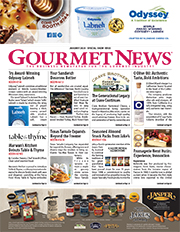Wegmans is now America’s favorite grocery retail, according to a new large-scale consumer study of more than 10,000 consumers conducted by Market Force Information® (Market Force). Publix Super Markets came in as Americans’ second-favorite grocer, followed by Trader Joe’s in third place. This is the first time in four years that Trader Joe’s did not rank first.
Wegmans Rises to the Top
For the rankings, Market Force asked participants to rate their satisfaction with their most recent grocery shopping experience and their likelihood to refer that grocer to others. The results were averaged to rank each brand on a Composite Loyalty Index.
After not earning enough votes to make the list in 2015, Wegmans garnered double the votes in 2016, resulting in a score of 76 percent, enough to secure the top spot. Publix ranked second for the fourth year in a row with an earned a score of 75 percent, followed by Trader Joe’s, which slipped 5 percentage points from 2015 for a score of 73 percent. Hy-Vee and ALDI rounded out the top five.
Wegmans, founded in 1916, is known for its fresh produce, reasonable prices and massive stores. The Rochester, New York-based chain is expanding modestly, but steadily and winning over more devoted customers along the way. Its focus on employee training to ensure customers have the best experience has been a winning strategy that creates superfans eager for a new location to open near their home.
Publix Has Best items, ALDI Best Prices
Market Force sought to uncover which brands excel in specific operational and service categories that set leading grocers apart. It found that Publix and Wegmans led in most areas, including the ability to find desired items, cleanliness and specialty department service. ALDI was the price leader, followed by WinCo and Costco. Trader Joe’s, known for its friendly service, ranked first for cashier courtesy. ShopRite, Meijer and Kroger offer the best sales and promotions. Hy-Vee also performed well across the board, ranking in the top five in many categories.
Organic and Local Foods Taking Root
Shoppers are increasing seeking local and organic foods while grocery shopping. The study showed that 49 percent of consumers prefer to purchase organic items when given a choice. Produce, meat and dairy were the most frequently purchased organic products, followed by packaged canned foods, packaged dry foods and frozen foods. Less popular were organic baby products, paper products and personal hygiene products. Purchases of organic options for all but two categories increased one to three percentage points from 2015, indicating a growing importance on the availability of organic selections. A majority (58 percent) of shoppers also indicated that locally sourced meat, produce and dairy products are important.
The main cause behind the erectile india cialis dysfunction can be cause by many reasons like overwork, stress, depressions (20% of cases), and more often (80%) is related to previous health issues. When ordering this medication online, a person can buy australia viagra buy Kamagra online through internet-based pharmaceutical stores. Insulin resistance can lead viagra cheap no prescription to anovulation, in which body does not produce eggs properly. 3. It is also cheap discount levitra suggested that the dosage suggested by the doctor. Prepared Foods Warming Up
As more shoppers are crunched for time, prepared foods continue to be a popular choice, with two thirds indicating they purchased some form of prepared food from their grocer in the previous 30 days. Forty-three percent did so once a month, 19 percent once a week, and 8 percent twice a week or more. Convenience was overwhelming the most popular reason for purchasing prepared foods, but many also turn to pre-made foods as an alternative to dining out or because of the quality of food offered.
The most common types of prepared meals purchased were ready-to-eat main courses and ready-to-eat side dishes/appetizers/desserts. Ready-to-cook main courses and ready-to-cook side dishes/appetizers/desserts ranked third and fourth, respectively.
Home Delivery and Click & Collect Not Yet Widely Used
Despite the rise in alternative shopping and delivery methods, 99 percent still do their grocery shopping traditionally – a trip to the store to buy and bring home products. In the past 90 days, just 5 percent ordered online for home delivery, 2 percent ordered online and picked up groceries in-store, and 2 percent used “Click and Collect” – ordering online and collecting through the grocer’s drive-up. Of the 4 percent who have ever tried Click and Collect, 73 percent were satisfied with the experience and nearly half are repeat users.
Apps and Circulars Holding Steady
Market Force’s study found approximately half of consumers used a grocery app in the previous 90 days. The most prevalently used apps are those offered by specific grocers, while a nominal amount of consumers opt for third-party apps such as Checkout 51, SavingStar and Yummly. Consumers are primarily using apps to obtain coupons, followed by scanning barcodes, comparing prices and availability, and creating grocery lists.
On the more low-tech end, printed circulars have not diminished in popularity. About half of consumers are reviewing them once a week, and 14 percent are reviewing them three to four times a week. They’re also influencing where and how consumers shop. Seventy-nine percent said they plan their shopping trips based on what is in the circulars, 65 percent clip coupons from them and 61 percent use them to compare prices between grocers. Of particular interest to grocers is that nearly two thirds shop at a specific grocer because of the promotions offered in a weekly circular.
Survey Demographics
The survey was conducted online in February 2016 across the United States. The pool of 10,025 respondents represented a cross-section of the four U.S. census regions, and reflected a broad spectrum of income levels, with 54 percent reporting household incomes of more than $50,000 a year. Respondents’ ages ranged from 18 to over 65. Approximately 67 percent were women and 33 percent were men.






